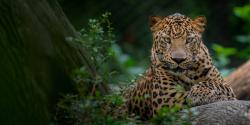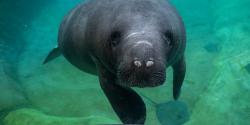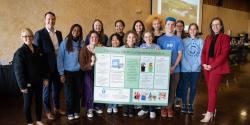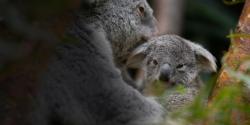NOTE TO MEDIA: A media kit, including images, b-roll, and interviews, are available in this Dropbox folder. Photo credits are contained in the file name (example: Grahm S. Jones, Columbus Zoo and Aquarium). Video credit can be provided to the Columbus Zoo and Aquarium.
Cumberland, OH – The Wilds, Wildlife Restoration Foundation (WRF), InterTribal Buffalo Council (ITBC), and Cheyenne River Sioux Tribe have successfully relocated 74 bison from The Wilds conservation center in Ohio to the Cheyenne River Sioux Reservation in South Dakota. This significant transfer marks the first major achievement for The Wilds' steps in a new bison conservation plan and exemplifies a robust and collective commitment to both ecological and cultural preservation.
"The transfer of these bison is a crucial step in our mission to restore this keystone species to its native range while respecting the profound cultural connections many tribes and communities have with the bison," said Vice President at The Wilds Dr. Joe Smith. "This collaborative effort underscores the vital importance of bison in maintaining the health of prairie ecosystems and in supporting cultural heritage."
The Wilds, in collaboration with the Columbus Zoo and Aquarium, is leading the way in bison conservation through the establishment of the North American Center for Bison Conservation. This initiative leverages the expertise of The Wilds staff, WRF, ITBC, and various federal, state, and tribal entities, private conservancies, and zoological facilities to manage large-scale bison herds to further bison conservation both in professional care and in wild protected areas.
Conservation and Cultural Significance
The American bison is a keystone species, essential for the health and diversity of prairie ecosystems. Once spanning over 142 million acres across the United States, these prairies are now one of the most endangered ecosystems, with less than 5 percent of its previous distribution remaining. Bison play a crucial role in maintaining native vegetation through their grazing, adding nutrients back to the soil, and even creating shallow wetlands through wallowing that benefit amphibians and birds, as well as a wide range of other plant and animal species.
Culturally, the bison holds immense significance. It is the National Mammal of the United States. Bison is also a species that has played a foundational role in the lives of Tribal nations across the Great Plains who utilize bison for food, shelter, clothing, and in traditions and spiritual rituals.
However, the near extinction of American bison due to over-hunting and westward expansion not only affected the grassland ecosystems but severely impacted the tribes that had deep connections to bison. Efforts to restore bison populations are not just about conservation but also about reclaiming cultural identity and traditions.
A Model for Bison Conservation
Working with partners, The Wilds is championing a comprehensive approach to bison conservation. With help from WRF, The Wilds is transitioning its herd of approximately 150 bison on 600 acres into a prototype conservation herd managed by a zoological institution. This involves:
- • Maintaining natural herd structures and behaviors
- • Ensuring genetic diversity and quality
- • Implementing advanced herd management and health strategies
- • Restoring native grasslands
- • Enhancing public education and guest experiences
Milestone Transfer Details
After months of careful and collaborative planning to ensure that all went smoothly, on May 9, 2024, The Wilds, Wildlife Restoration Foundation, InterTribal Buffalo Council, and Cheyenne River Sioux Tribe (CRST) successfully moved 74 bison to the Cheyenne River Reservation, home to the four bands of the Titunwan People of the Plains.
To perform a traditional CRST ceremony giving thanks for buffalo, CRST Tribal Elder Ivan Looking Horse traveled to The Wilds for the day of departure. Involving The Wilds staff, the moving ceremony was held before the bison departed on their journey to their new home. It included tribal prayers in the native language of the CRST and burning of the sage.
The bison were safely transported in two large livestock trailers during an 18-hour drive straight through to the Reservation, thanks to the expertise of partners and drivers from ITBC and CRST. The bison included seven females born in 2022, 63 young bison born in 2023 (33 females and 30 males), and four breeding bulls.
“The bison are happy and content in their natural habitat on the plains of South Dakota on the Cheyenne River Sioux Reservation,” said Jayme Murray, CEO, Cheyenne River Buffalo Authority Corporation. “They will remain isolated from our main herd for about 30 more days per our herd health protocols at which time they will be integrated into our herds to promote genetic diversity. Thank you to The Wilds and everyone who made this possible.”
In addition to helping to restore bison to their prairie habitats, the Tribe also plans to utilize the bison for cultural education, community events, and nutrition. Some bison may be harvested through traditional field methods as part of the Cheyenne River Sioux Tribe's Farm-to-School program, supported by United States Department of Agriculture (USDA) grants, which aims to provide bison meat at affordable prices to local schools, enhancing both nutrition and cultural education.
Looking Forward
“It was great visiting The Wilds’ facilities and staff. We can tell how dedicated they are to the health and wellbeing of all of the animals in their care,” said ITBC Technical Services Assistant Thomas Peters, who drove one of the trucks. “The transfers to Cheyenne River went splendidly and the buffalo are enjoying their new home. We look forward to continuing this partnership with The Wilds.”
This partnership represents a significant step towards sustainable bison conservation and cultural revitalization. As The Wilds continues to refine its Strategic Implementation Plan, the focus remains on amplifying wild bison traits, improving herd health, and fostering collaboration with conservation and tribal entities.
“The Wilds is proud to collaborate with our esteemed partners on this vital initiative. Together, we are not only working to restore a species that plays a crucial role in our ecosystems but also upholding a cultural tradition that enriches important heritage for Tribal nations,” said Dr. Smith. “This effort exemplifies our organization’s mission of Empowering People. Saving Wildlife., and we are committed to making a lasting impact for both nature and communities."
“Restructuring, diversifying and improving the genetics of The Wilds bison herd is what we were brought on to help do,” said WRF president Julie Anton Randall. “We are thrilled to have worked with ITBC to place all the dispositioned bison with the CRST near the Cheyenne River, South Dakota!”
For more information about The Wilds’ conservation initiatives, educational offerings, how to become a member, or to schedule a tour, please visit TheWilds.org and follow The Wilds’ social media accounts on Facebook, Instagram, X, and TikTok.
###
MEDIA CONTACTS
- The Wilds – Jen Fields, jen.fields@columbuszoo.org; Nicolle Gómez Racey, nicolle.racey@columbuszoo.org
- Wildlife Restoration Foundation – Julie Anton Randall, jantonrandall@wildlifeandparks.org
- InterTribal Buffalo Council - Shaina Clifford, shaina@itbcbuffalonation.org
- Cheyenne River Sioux Tribe – Alli Moran, Alli.Moran@crstmail.com
About The Wilds
The Wilds sits on almost 10,000 acres of lush landscapes along the Appalachian Byway and attracts nearly 120,000 visitors annually. With the mission of Empowering People. Saving Wildlife., The Wilds is among one of the largest, cutting-edge conservation centers in North America and is home to more than 500 animals representing 28 rare and endangered species from around the world. The Wilds operates tours, overnight accommodations, special events, and summer camps as a source of revenue. The Wilds is located at 14000 International Road in Cumberland, Ohio, about 90 minutes east of Columbus. The Wilds is open year round, with a full line of tour options running from May through October and specialty tours available from November through April. For more information, visit TheWilds.org.
About the Wildlife Restoration Foundation
The Wildlife Restoration Foundation (www.wildlifeandparks.org) is a 501c(3) nonprofit organization based in Virginia with a mission to use partnerships to directly and measurably increase native wildlife population viability and foster wildlife coexistence with human communities. Through neutral facilitation and resources, WRF empowers partners to intervene with direct and innovative conservation measures on the ground and in the water. For more information, visit www.wildlifeandparks.org.
About the InterTribal Buffalo Council
The InterTribal Buffalo Council (ITBC) is a collection of 80 tribes in 20 different states that facilitates the management of over 20,000 buffalo. Our members manage more than 32 million acres of Tribal lands and have restored buffalo to nearly 1 million of those acres. From the large intact grasslands of Montana to the small desert herds of New Mexico, ITBC is committed to reestablishing buffalo herds on Tribal lands in a manner that promotes cultural enhancement, spiritual revitalization, ecological restoration, and economic development. For more information, visit www.itbcbuffalonation.org.
About the Cheyenne River Sioux Tribe
Our Lakota Nation is comprised of over 3 million acres of beautiful nature with three major waterways, including the Missouri River, the Cheyenne River, and the Moreau River located in central South Dakota. The Cheyenne River Reservation is home to the four bands (Tiospaye) of the “Titunwan” People of the Plains: The “Mnicoujou” Planters By The Water, “Oohenumpa” Two Kettle, “Itazipco” Without Bows, and “Siha Sapa” Black Foot. The present land base of the Cheyenne River Indian Reservation was established by the 1851 and 1868 Fort Laramie Treaties and the Sioux Act of 1889. Prior to this, the bands placed within this reservation knew no boundary to their territory. They were hunters and traveled frequently in search of their main food source, the sacred American bison or buffalo. For more information, visit:
https://www.cheyenneriversioux.com/.









